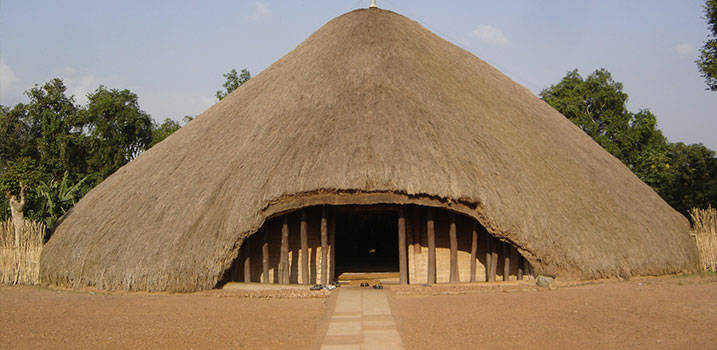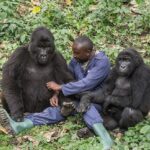The Kasubi Tombs is a UNESCO situated on a hill within Kampala Uganda is the burial grounds of 4 Kabakas (Kings of Buganda) and other members of the Buganda royal family. This makes it a very important religious centre for the royal family a place where the Kabaka and his representatives frequently carry out important rituals related to the Ganda culture.
The Buganda kingdom dates back to the 13th century and since then they have had 36 kings. To the Baganda the king is the unquestioned symbol of spiritual, political and social state of the Buganda nation.
The Kasubi Tombs are an important spiritual and political site for the Ganda people as well as an important example of the traditional architecture.
To this it became a UNESCO World Heritage site since December 2001 when it was described as one of the most remarkable buildings using purely vegetal materials in the entire region of Sub-Saharan Africa.
The first Kabaka to be buried at Kasubi tombs was Muteesa I who was the 35th King. The dates of the reigns of the Kabakas are only precisely known from Kabaka Suuna II, who ruled from 1836 and 1856.
The 4 Kabaka’s at Kasubi Tombs
Kabaka Muteesa 1
Muteesa 1 was born around 1835 and was crowned in 1856. He established his palace at Kasubi tombs in 1882, as did his father, He died in 1884 and his body was buried, whole at his palace, Kasubi.
He had decreed that his jaw bone should not be removed from his body. He thus broke two traditions; first being buried whole and second being buried in his former palace at Kasubi.
Mwanga 11
He succeeded his father in 1884 and was the last Monarch of an independent Buganda. Mwanga II, who had by then been christened Daniel, died there in 1903 after he had been exiled to the Seychelles Island in the struggle against the British colonial rule. His remains were brought back in 1910 and buried at Kasubi.
This again broke the Old tradition of burying Kabaka’s at different sites thus making Kasubi an important burial site of the Kabaka’s of Buganda.
Kabaka Daudi Chwa II
His son Daudi Chwa succeeded him at the age of one year in 1897. He ruled with a regency of 1 catholic and 2 protestant chiefs until he attained maturity at the age of 18 years. Daudi Chwa died in 1939 and he was also buried at Kasubi Tombs with his two predecessors.
This strengthened further the ritual value of the Kasubi Tombs.
Kabaka Muteesa II
His son Edward Muteesa 11 succeeded him. In 1953, a conflict developed between the king and the then Governor of the Uganda protectorate sir Andrew Cohen over Changes in the Buganda Agreement of 1900.
Muteesa II was exiled in England and he was returned in 1955 before Uganda attained independence from the British on 9th October 1962. Amidst increasing tensions which culminated in the storming of the Kabaka’s palaces in May 1966. He escaped and went to Exile in England.
He died in 1969 in London and his remains were brought back and buried at Kasubi in1971. Later after, his Son Sabassaja Kabaka Ronald Muwenda Kimera Mutebi II also returned from Exile and was crowned in 1993.
The coronation has helped catalyze a cultural renaissance amongst the Baganda and many of whom had little awareness of the Ganda Traditions.
With all these four Kabaka buried at the same site, the Kasubi Tombs became a re-known important Shrine in Buganda’s history. Each prince and princess who is a descendant to any of these four Kings is buried at Kasubi behind the main shrine.
Consequently, apart from its ritual value, the site has also become culturally important as the cemetery of the royalty of the Buganda Kingdom.
The Kasubi tombs hill contains a number of buildings and graveyards and large area on the site is used primarily for agricultural purposes.
On entrance Kasubi Tombs have a beautifully built gate house called Bujjabukula. It leads to a small courtyard which contains the Ndoga- Obukaba, a circular house in which the royal drums are kept. From this forecourt, one enters the main courtyard (Olugya) enclosed by a reed fence and several houses built for the widows of the Kabakas and for other ritual purposes.
The entrance into this county yard is a striking experience as one immediately faces the main tomb building known as Muzibu-Azaala- Mpanga, which is the architectural masterpiece of this ensemble.
The first palace was originally built by Mutesa I’s father; King Suuna II in 1820 which does not exist anymore. The main building that can be seen today was re-built in 1882 by Mutesa I.
On entering the courtyard, the attention of the visitor is immediately captured by the beauty of the thick thatched roof which extends all the way down to the ground.
The thatching technique at the kasubi Tombs is quite unique and can hardly be compared to another African or European thatching technique.
The grass is prepared in conical bundles which are simply laid onto the roof structure without being tied, except for the first layers at the bottom. When one of these bundles is rotten, it can simply be pulled out and replaced. This interesting technique makes the huge maintenance task of the thatched roofs much easier.
The thatching is carried out by the members of the Ngeye Clan ( Colobus monkey clan), who are the only people allowed to do the work. Its inside is partitioned with a huge bark cloth which separates the “sacred Forest” where the four royal graves lie. Entrance to the “sacred forest” is limited to the widows of the Kabaka’s, the royal family, the Nalinya and Katikkiro.
The inside of the house is adorned with power insignias such as drums, spears, shield, medal and photographs of the Kabakas buried there. The floor is covered with a thick layer of lemon grass and palm leaves mats.
The whole structure is supported by gigantic straight wooden poles wrapped in bark cloth. This creates striking impression of harmony and power.
Special rules are respected when fixing a roof. The widows for example are not allowed to enter the building when it is being thatched as it is believed that their presence would cause leakage.
Pregnant ladies are also not allowed inside during repairs. Similarly, the thatchers are not supposed to have sexual intercourse during the thatching period. The fabric made from the soft bark of the fig tree (ficus natalensis) is one of the fascinating Ganda skills. This bark cloth has a strong ritual importance to the people of Uganda.
To make this soft and resistant fabric, the outer bark of the tree is carefully removed and then alternately soaked and beaten with a grooved wooden mallet, until the fibers to become flexible.
Bark cloth was traditionally popular for clothing, but today, bark cloth is rather used for craft products such as hats, mats, book covers, purses and many other items. It is also used to wrap dead bodies.
As a matter of fact, the bark cloth is a respected item in the burial ceremonial of quite a number of communities in Uganda.
The tombs and the entire site environment carry strong spiritual and social significance.
he architecture itself carries meanings related to the Ganda traditions. The rich decorative features, invested with spiritual values, reflect the interaction between nature and culture, between the spirits and the living people.
One example is the fifty two rings of spear grass that were binded and support the great roof of the tombs. They represent the Ganda of clans which are 52 in number.
Apart from the royal burial ceremonies, other traditional rituals are carried out at the Kasubi Tombs throughout the year. They include; the new moon ceremony and the consultation of the mediums.
This aspect of the Ganda traditional is well known by the population and it is still respected. At Kasubi when a King or a member of his family dies, they immediately enthrone a successor, and after the burial they perform rituals to appease the spirits.
Animals are sacrificed and gifts of various kinds including money are deposited in the numerous shrines.
Kasubi is also visited by a wide range of Baganda medicine men and women who consult the kings’ spirits to obtain blessings in their trade.
The rich intangible heritage of the site is crucially important to the continuity of its heritage value.










